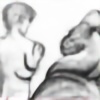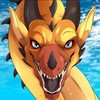HOME | DD
 LeccathuFurvicael — Entry - Triquestered Faragast
by-nc-nd
LeccathuFurvicael — Entry - Triquestered Faragast
by-nc-nd

Published: 2009-12-07 06:23:22 +0000 UTC; Views: 2508; Favourites: 46; Downloads: 0
Redirect to original
Description
EDIT:



 1st place winner in ~AbelPhee 's Creature contest!
1st place winner in ~AbelPhee 's Creature contest!




Ah, the time has finally come... for my submission to 's creature contest!!




 Woo! And a whole day after the deadline. XP
Woo! And a whole day after the deadline. XPClick on the image to see the large size, but watch out dial-up users - it's BIG. Sorry!
And now, my creation... BEWARE OF WALL OF TEXT!!!
--------------------
Triquestered Faragast
Scientist's Journal, December 7th, 2009
Only recently discovered by spelunkers, this oddity has yet to be fully studied - a deceased specimen has been able to be collected and, while a wealth of information, examination is still underway.
The Triquestered Faragast is seen to live in subterranean environments, preferentially around bodies of water that are superheated by geothermal activity, and thrives both on land and water, as long as a source of deep water is accessible and in short range.
Physical description:
The specimen collected has been measured to be around ten feet long, four feet high, and weighing around 350 pounds.
When in water, the Faragast will use all four webbed limbs and its thick, powerfully muscled tail to propel itself through the water, its forelimbs used primarily as directional guides. Upon landfall, the animal is seen to walk on its hind limbs predominantly, though will rest upon all four limbs and will use all four limbs when navigating narrow passageways. The tail is dragged along behind the animal in land-bound situations.
The exaggerated fin-like forms on the animal are still pondered on for their purpose: the two large 'sails' on the sides of the body are easily used as stability planes in the water, yet the paired fins along the back of the Faragast's jaw have yet to be placed with a purpose.
The fins as signs of fitness has nearly been ruled out as these creatures do not have sophisticated eyes: only several small light-sensing organs have been found on the top of the head, most densely collected around the region of the nostrils. The nostrils are located on the top of the head to allow for the creature to breathe above the water's surface with little effort to bring the head above water.
Both lateral and jaw-positioned fins are able to spread and collapse.
What is perhaps more curious than the fins are the bony protrusions along the sides and top of the head - the most prominent is a triangular 'keel'-like form, along with paired, curving spines further back on the top of the head, and paired, irregularly-shaped protrusions on the sides of the head at the base of the skull. It is postulated that these are structures that detect its surroundings, much like the lateral lines of fish.
Further structures for detection are found along the bottom of the jaw and around the jaw-positioned fins - fleshy whiskers that vary in thickness and length. The longest whiskers are found on the underside of the Faragast's jaw, and are oddly kinked.
The jaws of the Faragast are much like a fish's jaw structure - there are several interconnected bones and joints that allow the mouth to open wider and further out than originally expected. Even so, the Faragast has a proportionally small mouth for such a sizable creature.
The mouth is filled with a single row of small, needle-shaped teeth, designed to grasping on to fish, though can be used to consume similar organisms such as aquatic invertebrates. The tongue is small, triangular, pale in color, and fairly immobile.
The overall body composition of the Faragast is relatively long and thin, with a flexible back and neck. The back is covered with spiny plate-like forms. The skin is leathery and relatively smooth, and pronounced, overlapping scales are found on the forelimbs. These are found no where else. The tail is covered by interlocking, thickened '




 lates' of hide, coming together in the last few segments to create a flattened, webbed tip. The structure of the tail is similar to that of a crocodilian, apart from the webbing. Along the top of the tail for the first number of segments are long, thin spines made of hardened material, and seem to grow from the epidermal layer itself - no skeletal structure is found within these spines. They are fairly inflexible.
lates' of hide, coming together in the last few segments to create a flattened, webbed tip. The structure of the tail is similar to that of a crocodilian, apart from the webbing. Along the top of the tail for the first number of segments are long, thin spines made of hardened material, and seem to grow from the epidermal layer itself - no skeletal structure is found within these spines. They are fairly inflexible.The hind feet are also covered in toughened material very similar to the spines' composition, yet are jointed at the toes to provide mobility. Spines that have grown out of the lateral sides of the hind feet have skin growing in between them, increasing the hind foot's ability to push water backward while swimming.
The Faragast, while alive, has only been seen to be a small range of colors, mostly all pale, but are darker in areas where keratinous material is found - in the spiny plates on the back, the cranial protrusions, the fin rays, and the tail. The pale color of the animal ranges from a light yellow pallor to a pale white.
In examination of the body, it is has been found that the specimen collected has no specific gender - it has found to be parthenogenic, in which it gives live birth to copies of its own genes. No large differences have been seen in appearance of Faragasts in the wild - it is postulated that the population observed all are parthenogenic.
As well, pores have been found around the animal's head, limbs, and back that secrete a foul-smelling, opaque liquid. It has mildly toxic and corrosive qualities. It is unknown what the purpose of these are - perhaps for identification, but has a major deterrent agent as well. It is hard to imagine what other organism may endanger these creatures to lead them to adapt such a defense, but it is unclear if that is the true reason behind these pores.
Behavior:
In observation of this creature in the wild, the Faragast consists mainly on fish and small invertebrates, but will eat algae or other plants on occasion, where it scrapes the material off of its base with its flattened mouth and needle-like teeth.
The Faragast is seen to posses ambushing tendencies, where it will wait underwater or out of water to capture prey, but will primarily forage openly for food. They will traverse to other water sources if necessary, and cannot live in completely submerged areas for long due to their need for air. They have been able to hold their breath for about 20 minutes at the most, from our experience.
The animal will obtain its prey with a combination of suction force upon opening the mouth, as well as the gripping teeth that hold prey in place once captured.
Faragasts are isolated animals, and do not live among others of their kind. If one Faragast comes upon another, they will move on immediately to obtain a place of their own. It is not known if Faragasts have placed territories.
----------------------------------------
Time to create: Around 8+ hours for whole digital image, the course of a week or two for line drawings
If anyone has any questions about this thing, please ask! I'd love to try to explain different aspects of this.




 I've put a crapload of time and effort into this: even if I don't win or place in the contest, I really like this thing.
I've put a crapload of time and effort into this: even if I don't win or place in the contest, I really like this thing.Art and Concept (c) Stephanie Dziezyk/LeccathuFurvicael 2009. Do not redistribute, copy, alter, etc., any portion of this piece without direct permission from the artist.
Related content
Comments: 19

First, I want to say, 
👍: 0 ⏩: 0

Oh my! I have never seen a creature quite like this! As someone said above, I really wouldn't want to come across this critter in the water.
I just love the unique design; its fish-like mouth, its utterly fantastic webbed front claws, the detail of the muscles and plates around the base of the "sails." I imagine its bipedal walking is somewhat similar to that of a lizard's? Running or walking fast on its hind legs, then falling back to all-fours crocodile-style when only crawling is needed.
I really hope you win!
👍: 0 ⏩: 1

Why thank you! I am really glad that you like it so much. 
That would be an interesting method of locomotion for this thing, though from the hind limb anatomy I gave it, its legs are positioned directly underneath the hind limbs - they can splay outward somewhat (like when crouched/laying down), but can't really 'swing' like a lizards' hind legs can when running. These are more ponderous sorts of animals on land, though can be very quick and agile underwater.
Thanks for such a lovely comment! 

👍: 0 ⏩: 1

You have a good point about the leg movement, upon closer inspection I see the hind legs do indeed go underneath the body, not outward like a croc
You are very welcome! The lovely comments are well deserved
👍: 0 ⏩: 0

That is so clever and unique...you obviously put a lot of thought into this! I hope you win!
👍: 0 ⏩: 1

That was awfully kind of you to say. 
👍: 0 ⏩: 0

Ahhh, I tl;dr'd on your write-up. 
👍: 0 ⏩: 1

Don't worry - I did the same thing with other people's entries, so no offense taken.
'Sad and grisly and you-ish'? oO' What do you mean? *chuckles*
👍: 0 ⏩: 1

Well, you like drawing these creatures who are like, "I exist. Meh."
👍: 0 ⏩: 1

*laughs!* XD They could be seen that way, yeah.
'Yeah, I'm here - what are you gonna do about it?' sort of attitude.
👍: 0 ⏩: 0

*laughs* I had no idea... 
👍: 0 ⏩: 0

and to think you were ustreaming it all! Good deal with the aquatic and reptilian features. I noticed the gator tail like structure
👍: 0 ⏩: 1

Yeah, I was surprised that people were actually willing and stuck around for as long as they did - to that effect, thanks for popping by - it was fun to talk to you. 
Oh, and thanks for the comment. 

👍: 0 ⏩: 1

I got stuck on the orange one, the paint needed to settle badly from all my frustration with it. I may sand some off from yesterday and try again tonight with getting the colors and patterns right... I quit on it
👍: 0 ⏩: 0






































